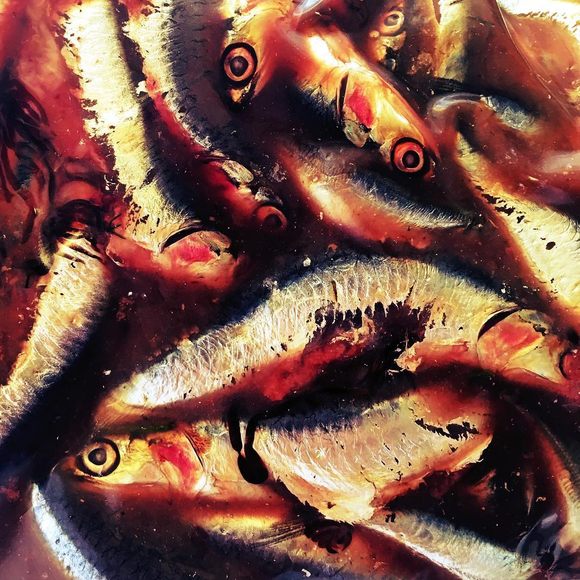Ingredients & Condiments
Garum
In ancient Rome, this fermented fish sauce sparked a booming industry.
Romans needing a recharge after a rousing chariot race likely dined on at least one food seasoned with the popular fermented fish sauce known as garum. A roast boar might have been covered in a garum-and-vinegar glaze, while eggs, oysters, and other seafood could be elevated with a sprinkling of the salty sauce.
Slaves and laborers made the aromatic fish sauce by chopping up whole fish, including their guts, and tossing them into large clay pots with salt (amounts varied). The concoctions were then left to ferment for at least nine months under the hot Mediterranean sun while halophilic, or salt-loving, bacteria from the fish’s guts helped break down the flesh. Archeological remains of coastal factories in southern Spain tell the history of the region’s manufacturing and export during the ancient Greco-Roman era. More local to imperial Rome, Pompeii also boasted a successful garum factory. In fact, archeologists were able to use garum remains at this site to more accurately date Vesuvius’s eruption.
While some famous Romans, such as Seneca, were known to grumble about the “overpriced guts of rotten fish,” Pliny the Elder prized the “exquisite liquid.” And though authentic garum isn’t sold on the market today, one descendant, called colatura di alici, remains popular in southern Italy and various chefs have tried their hand at ancient recipes. Ken Albala, a food historian, recreated a garum recipe found in a 10th-century agricultural text. Albala described the resulting umami bomb as “a riot of flavors and textures” and that the fermentation process resulted in a sweet rather than funky aroma.
Regardless of how you might feel about fermented fish guts, a modern go at the recipe might not be a bad idea. Garum was not only a flavoring agent, but an important source of protein in ancient Roman diets. In many parts of the world, particularly Southeast Asia, fish sauces continue to provide essential nutrients today.
Written By
 Luis Morato
Luis Morato
Sources
- www.lavozdigital.es/gurme/reportajes-bares-y-restaurantes/jerez-de-la-frontera/vinagre-imperio-romano/
- basmatic.com/garum-salsa-conquisto-imperio-romano
- www.amazon.es/s/ref=as_li_ss_tl?__mk_es_ES=%C3%85M%C3%85%C5%BD%C3%95%C3%91&url=search-alias=aps&field-keywords=colatura+di+alici&sprefix=colatura+,aps,173&crid=1B36HLYWCMZG4&linkCode=sl2&tag=k0fe6-21&linkId=fe6d9b4cc5dada8e5b719519da5f32ca
- www.npr.org/sections/thesalt/2013/10/26/240237774/fish-sauce-an-ancient-roman-condiment-rises-again
- doi-org.proxyiub.uits.iu.edu/10.1081/FRI-100000515
- doi-org.proxyiub.uits.iu.edu/10.1002/jsfa.1013
- www.pompeii-food-and-drink.org/garum.htm
- www.jstor.org/stable/3295259
- books.google.com/books?id=LNsuDwAAQBAJ&pg=PT180&lpg=PT180&dq=garum+%22more+expensive+than+perfume%22&source=bl&ots=zvHlfQVTba&sig=9QeqaRdSwtCX0X0Hifxy8ktlsmo&hl=en&sa=X&ved=2ahUKEwihpcm47ZXdAhUCJt8KHfF7BIkQ6AEwAHoECAMQAQ#v=onepage&q=garum%20%22more%20expensive%20than%20perfume%22&f=false



















